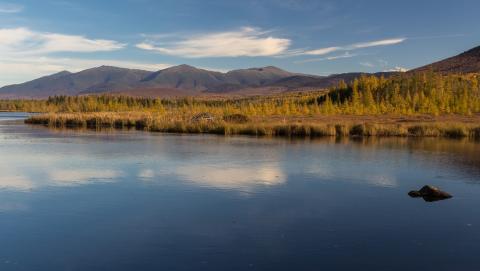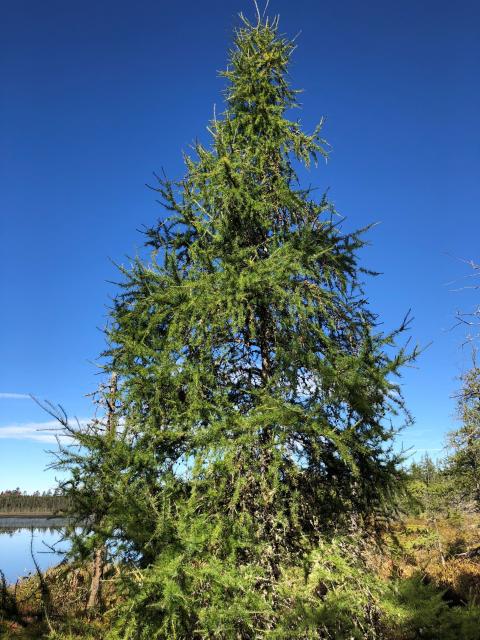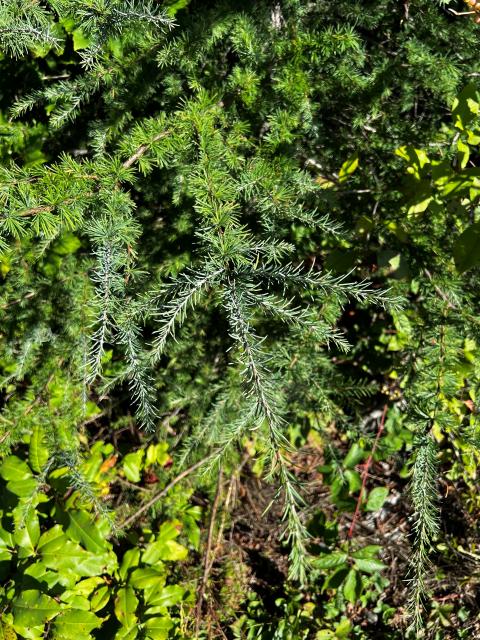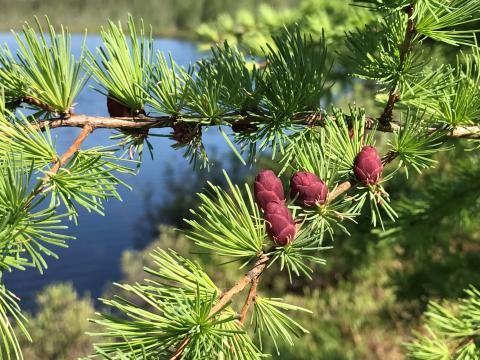Autumn Gold: Tamarack

New Hampshire has three distinct autumn foliage periods. First to arrive is the brilliant scarlet of swamp red maples turning in early September, followed by the rich red and orange of sugar maples in late September. Finally, we have a third spectacle that begins mid-October and runs into early November. This period is the time of Autumn Gold, when the tamarack needles turn golden against a boreal blue sky, with the sound of migrating Canada geese overhead. This mini-season even has a unique name called Aut-Win, the season between Autumn and Winter.
Tamarack, or American larch, is a remarkable and colorful tree of New Hampshire. It is the only native conifer in New England to drop all its needles in Autumn and regrow them next Spring. Tamarack is one of three native larch species in North America, the other two being Western and Subalpine Larch. All three larch species turn a vibrant gold each Autumn and attract many visitors to admire the foliage. There are ten larch species worldwide, all in the northern hemisphere.

Tamarack is a mid-sized, pyramidal-shaped, deciduous conifer with pale-green tufts of needles clustered on a spur. Tamarack is a species typically found in bogs and peatlands. The scientific name of tamarack is Larix laricina. The genus Larix comes from the Celtic word for “fat” and describes the oily feel of the wood. The species name laricina means "like a larch," referring to its similarity to European larch or Larix decidua. Larch is in the Pinaceae or pine family.
Tamarack is extremely cold tolerant and grows in the coldest places across North America, where the temperatures can drop to -60 F. The range of tamarack extends from Labrador and Newfoundland west to the Yukon and Alaska. Tamarack grows throughout New England, except for Cape Cod and southern Rhode Island. A few relict populations in cold bogs exist as far south as Maryland and West Virginia.
Some of the best New Hampshire locations to see Autumn Gold in late October are the Pondicherry National Wildlife Refuge (NWR) in Jefferson and the Umbagog NWR in Errol. At Pondicherry NWR, Cherry and Little Cherry Ponds along with the access trails have abundant tamaracks. At Umbagog NWR, try the Magalloway Trail off of NH 16 for a leisurely walk in nearly pure stands of tamarack. NH 16 from Milan to Errol and US Route 3 in Pittsburg to the border also have abundant tamarack to enjoy. Just watch out for moose as you drive these roads!
Fun Facts about Tamarack
Tamarack and white spruce have the widest ranges of North American conifers. Tamarack has the northernmost range of any tree species in North America and grows up to the Arctic tree line. Tamarack is known to grow at elevations up to of 4,000 feet in the Adirondacks, primarily on landslide tracks. However, the National Champion tamarack is in Tamworth, NH, and is 82 feet tall with a diameter of 37 inches! It is a relatively short-lived species at 100-150 years. The typical size of mature tamarack in New Hampshire is 50-60 feet tall with a diameter of 14 inches. The oldest known tamarack was found in Quebec and was 371 years old. Western larch is known to live at least 1,000 years, and subalpine larch can live nearly as long.
The common name Eastern larch is discouraged because tamarack grows in Alaska, further west than the range of Western larch. While American larch is another common name, perhaps it should be called Canadian larch because it is much more abundant in Canada. Tamarack is a native Algonquian word that means “wood for snowshoes.” Hackmatack is the Abenaki term used in New England derived from the word "akemantak.” Native Americans and First Nation people used tamarack roots to stitch together birch bark canoes. The terpenes found in tamarack wood make it durable when wet. Native people also use tamarack for dog sled runners, boat ribs, fish traps, and arrow shafts. The inner bark is a survival food source. Spruce grouse feed on tamarack needles and buds. Red crossbills and pine siskins feed on the seeds of the cones. Porcupine love to feed on tamarack and often completely girdle the tree by eating the nutritious inner bark.

Tamarack and other larch shed their needles to prevent water loss, decrease wind resistance, and shed snow in winter better. Tamarack needles do not have a waxy coating to prevent water loss found in other conifers. The shed needles are high in nitrogen, and much of this nitrogen will be reabsorbed by the tree next spring. Scientists believe that rest during the dormant period makes the tree healthier. If you see a tree with small tufts of pale green needles on the branches, it is sure to be a larch. It has the lightest colored foliage of any northeastern conifer and the needles are an inch long and twisted. Tamarack has two different types of needle arrangements on the same branch. Single needles cover the current year’s growth, while clusters of 10-25 needles grow on the short spurs of older branches. The twisted needles are very efficient food factories. The tufts of needles do not shade themselves like other conifers and broad-leaved tree leaves, thus maximizing photosynthesis.
Tamarack and black spruce are familiar associates. Both have seeds that can germinate on the peat moss of northern bog. It sometimes grows on floating mats of peat that get blown about in the wind. Growing in mixed stands with black spruce, northern white cedar, and balsam fir, tamarack is shade intolerant, prefers full sunlight, and is considered a pioneer species. Tamarack is usually found in bogs but grows fastest on moist, well-drained, sunny, upland sites.

Both male and female cones are on the same tree, and the pollen is wind-blown. Tamarack starts producing cones by age fifteen and has bumper crops every three to six years. Tamarack cone production in 2022 was poor. The small female egg-shaped cones are less than an inch in size and are bright red in early June, then turn a light brown color by early Autumn and ripen the first year. There are about 20 seeds per cone. In the northern part of its range, tamarack reproduces primarily by layering. Layering is when branches that touch the ground and then are covered in moss and sprout up as new trees.
Tamarack is naturally rot resistant and used for bog bridges on hiking trails in the White Mountains. The three-inch thick, eight-inch wide, eight-foot long tamarack planks will often last for fifteen years when used as a bog bridge. A green plank this size will weigh around 70 pounds. White Mountain Lumber Company in Berlin, NH, is one of the few suppliers of tamarack planks used by local trail crews.
David’s professional background was with the U.S. Forest Service, where he worked for 33 years until retirement in various positions and locations across the country as a Forester, Silviculturist, and Forest Fire Management Officer. David worked for 20 years on the White Mountain National Forest. Since his retirement, he works for RAVEN Interpretive Programs as a Naturalist. David has also worked as an expedition ship naturalist in Alaska and Iceland. Among his many roles David is a UNH Extension Volunteer for NH Big Tree, Coverts, and Speaking for Wildlife programs.